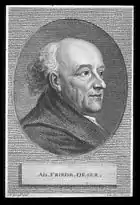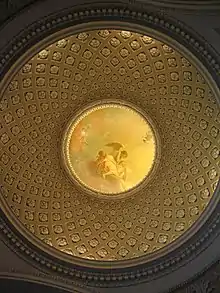
Adam Friedrich Oeser (17 February 1717 in Pressburg – 18 March 1799 in Leipzig) was a German etcher, painter and sculptor.
Biography

Oeser worked and studied in Pressburg (student of Georg Raphael Donner in sculpture) and Vienna at the Vienna Academy (student of Jacob van Schuppen and Daniel Grau in painting). He went to Dresden in Saxony in 1739, where he studied with Mengs and Dietrich,[1] and created portraits and scenes for the Royal Opera, and mural paintings in Schloss Hubertusburg (1749). In 1756 Count Heinrich von Bünau commissioned him to decorate the newly built Schloss Dahlen.
Oeser moved to Leipzig in 1759. Appointed director of the newly founded Academy there in 1764, he zealously opposed mannerism in art. He was a stout champion of Winckelmann's advocacy of reform on antique lines. He also befriended Winckelmann, who lived with him and his family in 1754/55.[2]

Oeser's chief importance was as a teacher. He was the drawing teacher of Johann Wolfgang Goethe, with whom he kept up friendly relations afterwards at Weimar. Besides a number of decorative works, mostly ceilings, he painted mythological and religious canvases and portraits, among the best being: "The Artist's Children" (1766, Dresden Gallery), "Marriage at Cana" (1777) and four others in Leipzig Museum, and "The Painter's Studio" (Weimar Museum). His best effort in sculpture is the monument of Elector Frederick Augustus (1780) on the Königsplatz in Leipzig, which he created together with his student and architect Johann Carl Friedrich Dauthe.
In 1766 Oeser became a member of the Masonic Lodge Minerva zu den drei Palmen, Leipzig. In 1776 he became a member of the Balduin Lodge, Leipzig.
He resided in Germany. Among his pupils was Sophie Dinglinger.[3]
Notes
- ↑ Rines, George Edwin, ed. (1920). . Encyclopedia Americana.
- ↑ Karl Robert Mandelkow, Bodo Morawe: Goethes Briefe (Goethe's letters). 2. edition. Vol. 1: Briefe der Jahre 1764–1786 (Letters of the years 1764–1786). Christian Wegner publishers, Hamburg 1968, p. 554. "Seine Auftragsarbeiten folgten zunächst noch dem offiziellen barocken Stil, während seine Kunstanschauung, sein künstlerischer Geschmack sich bald einem neuen, klassizistisch ausgerichteten Schönheitsideal zuwandte. Klärend und vertiefend wirkte die Dresdner Begegnung und Freundschaft mit Winckelmann, der 1754/55 in Oesers Wohnung Aufnahme fand." ("In the commissioned works, he first still clung to the official baroque style, for a while, but he soon shifted to a new, classicistically oriented ideal of beauty in his taste and his personal view of art. The Dresden meeting of, and friendship with, Winckelmann exerted a clearing and deepening influence on him, connected to this. Winckelmann found accommodation in Oeser's flat in 1754/55.")
- ↑ Profile of Sophie Dinglinger at the Dictionary of Pastellists Before 1800.
References
- This article incorporates text from a publication now in the public domain: Gilman, D. C.; Peck, H. T.; Colby, F. M., eds. (1905). . New International Encyclopedia (1st ed.). New York: Dodd, Mead. This work in turn cites his biography by Dürr (Leipzig, 1879).